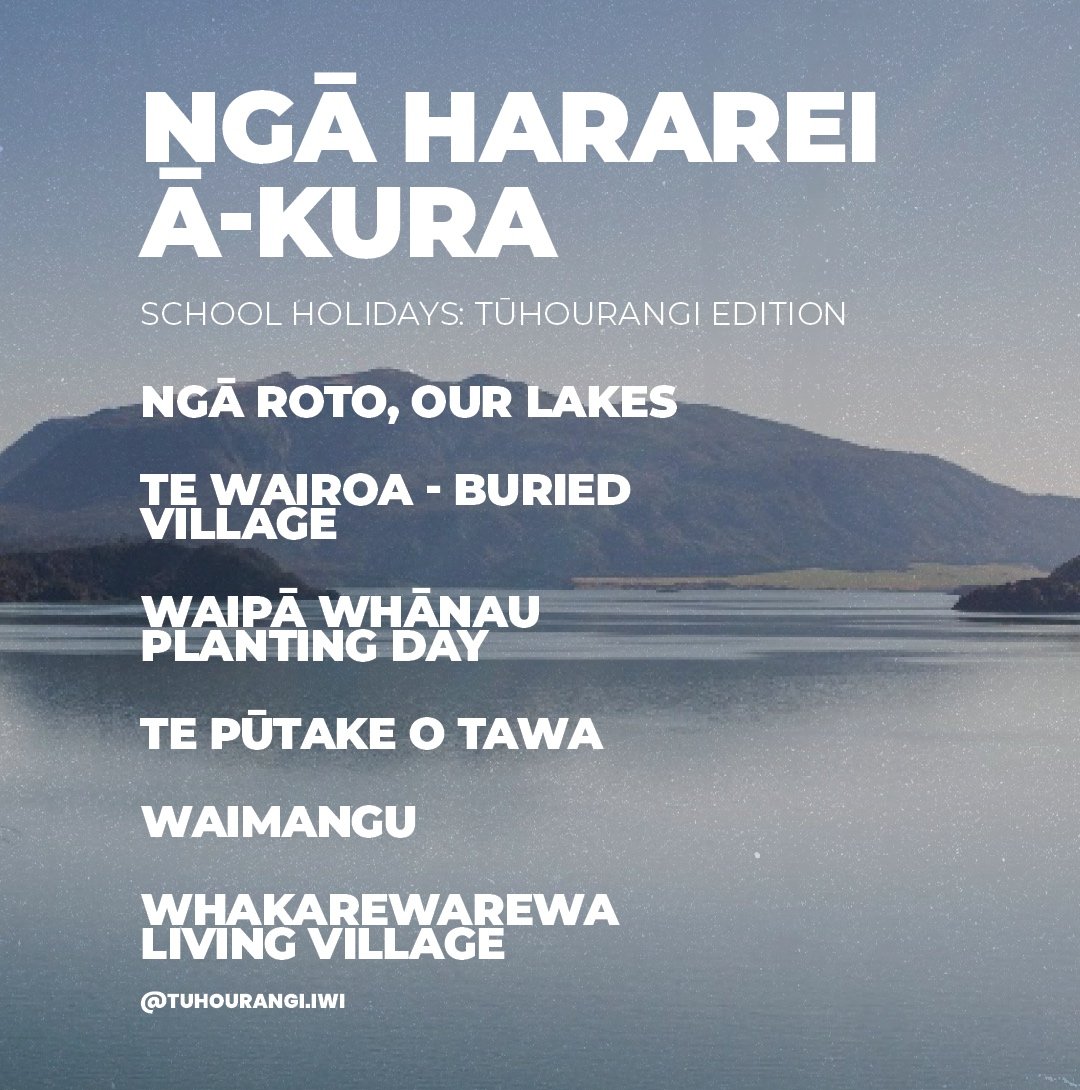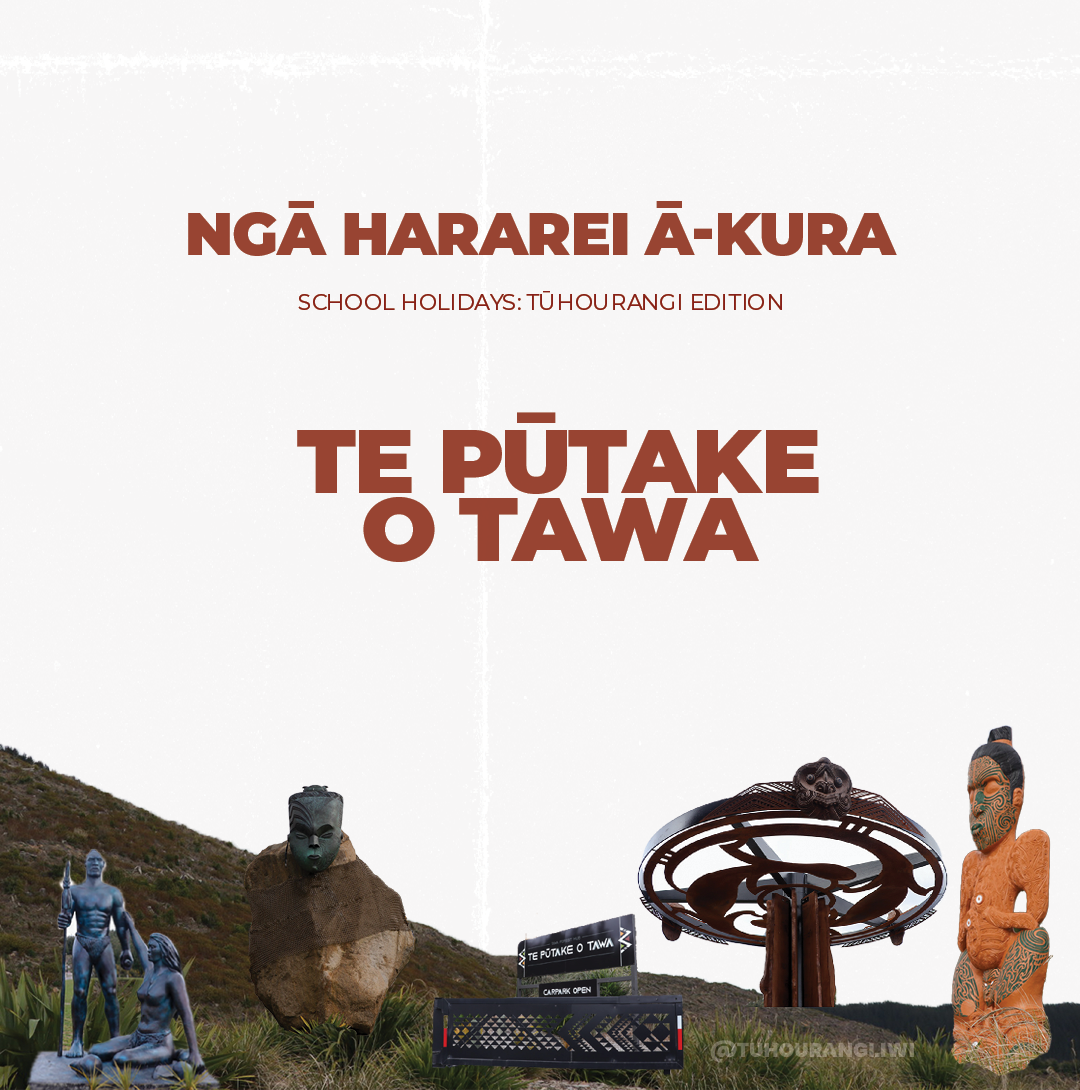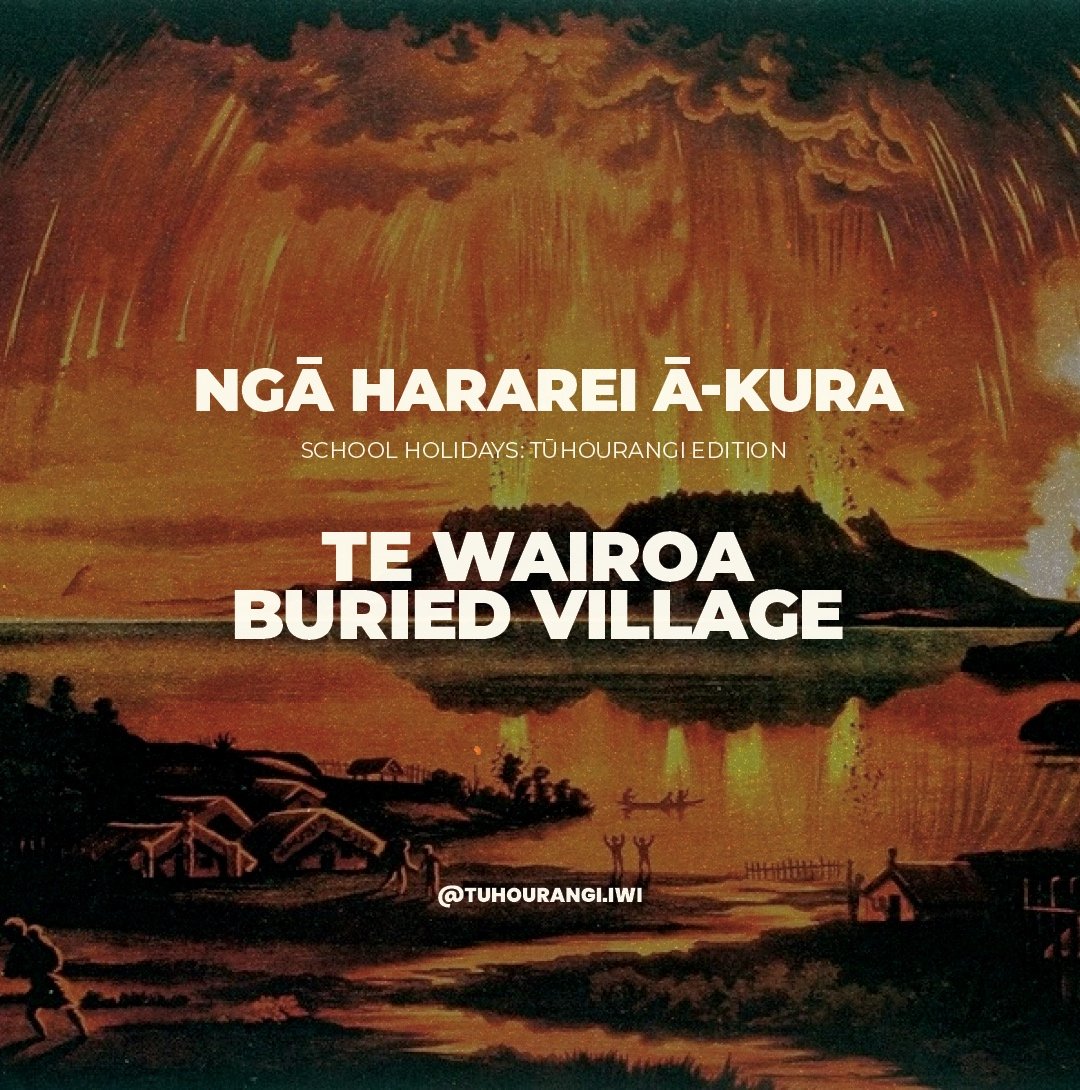PRESS RELEASE: Call to Action from Tūhourangi: Regarding the Threat of Golden Clams on Our Lakes
Call to Action from Tūhourangi: Regarding the Threat of Golden Clams on Our Lakes
Ngā Hararei-ā-Kura, school holidays: Tūhourangi Edition
We’ve put together a list of activities for whānau (and everyone) to help with the upcoming school holidays - Tūhourangi edition!
The places mentioned in our list are either:
on Tūhourangi whenua (lands)
have businesses owned by Tūhourangi uri (descendants) on them
are owned by Tūhourangi Tribal Authority - therefore, free for Tūhourangi uri to visit!
For further details please DM on our Facebook or instagram or contact admin@tuhourangi.iwi.nz







Wanted: Environmental Warriors
We’re looking to create a directory of Tūhourangi whānau working within the environmental space – we want to have as many of our whanaunga throughout Te Arawa as we can on our list so that we when opportunities become available, we can reach out to our own people first.
Do you have a passion for the environment? We're looking to add anyone that works around te taiao such as: pest management techs, environmental advisors, policy analysts, rangers, project managers, environmental lawyers, scientists, grassroots organisers – whatever your speciality is!
Reach out to Corey Ruha at corey@tuhourangi.iwi.nz with a name and number so he can add you (or a whānau member) to our directory.
Catfish Biocontrol Research in Te Arawa Lakes
He pānui nā Te Arawa Lakes Trust,
“We would like to let you know that we are investigating the use of alternative methods to control catfish in Lake Rotoiti and Lake Rotorua. This is so we can protect and care for our taonga species and the health of our lakes.
Catfish were first discovered in Lake Rotoiti in March 2016 then in Lake Rotorua two and a half years later. Despite massive netting efforts by our contractors and volunteers, the catfish population is now an estimated 186,000 in Lake Rotoiti (as of March 2020).
We know that catfish are devastating our kōura populations. We also know that catfish eradication is not feasible with the current tools available. For this reason, we are working with the Bay of Plenty Regional Council and NIWA on a research project to assess whether biocontrol, using sterile male catfish, would be an effective tool for Lake Rotoiti and Lake Rotorua.
These are catfish which are unable to successfully breed with other catfish. As a result, they disrupt the breeding success rate of wild catfish.
Over the next 12 months, we will be facilitating engagement hui to listen to your concerns and thoughts about this research project. We will also be:
• Identifying mātauranga māori-based research projects to both support the research requirements while also supporting post-graduate students of Te Arawa descent.
• Working with:
Ministry for Primary Industries and Department of Conservation to understand their respective permitting processes.
Fish and Game New Zealand regarding a potential site for a fish hatchery.
NIWA regarding research requirements e.g. catfish population dynamics.
We will be discussing this kaupapa at an engagement hui in September 2020. In the meantime, if you require any further information or clarification, please contact William Anaru on william@tearawa.iwi.nz or visit our website www.tearawa.iwi.nz
We look forward to your feedback to ensure that we can engage in this programme together for the protection and care of our waters.
Ngā mihi mahana,
Karen Vercoe
CEO - Te Arawa Lakes Trust
Tarawera - Connecting People and Place
The Tarawera Lakes Collective Impact Project was developed to connect agencies and communities where groups, each with their own set of skills and experiences can work together for a common purpose.
The purpose being Lake Tarawera and its declining water quality. Lake Tarwera is one of the iconic Rotorua District Lakes with seven lakes contributing to the health of Lake Tarawera (Ōkataina, Ōkāreka, Tikitapu, Rotokakahi, Rotomahana, Ōkaro and Rerewhakaaitu).
Te Arawa Lakes Trust has been tasked with scoping out how collective impact might work – in practice – for the Tarawera Lakes System.
Working collectively is a way of bringing together and harnessing the collective potential and energy of passionate people which can build on existing work happening within the attachments and enable innovation and multiple benefits.
To view and read the information sheet – please click here.
Next steps:
To provide feedback on this important kaupapa – please click here. The online survey is a way to share your thoughts to guide the way forward.
Hui-ā-iwi: Update
The hui dealt with two matters:
1. Equity
Consistent with previous decisions the hui unanimously supported the continuation of TTA work to have this matter addressed and resolved:
a. That TTA engage with TPT to request them to take legal advice and steps to obtain a declaratory decision.
b. If those discussions are unsuccessful, TTA to consult with the iwi before taking any further action.
A copy of the FAQ sheet that was shared at the hui is included below.
2. The Ngati Rangitihi overlapping interests at Tarawera and Rotomahana.
In response to prior hui-a-iwi, TTA trustees were able to confirm:
- Ngati Rangitihi makes no claim for fee simple title or statutory acknowledgement over any Tuhourangi lands as awarded to them through the Native Land Court (Rotomahana Parekarangi 6 lands).
- In respect of the whenua rahui over the Tarawera maunga, through the Te Arawa Collective Settlement legislation, the Crown is able to provide a similar rahui to Ngati Rangitihi.
- The Waimangu fee simple titles over three parcels of land initially offered by the Crown to Ngati Rangitihi were withdrawn, these can only be included with the consent of Tuhourangi. TTA with the support of Ngati Rangitihi and via their settlement propose to take the opportunity for the return of this Waimangu land and another parcel which borders the lake where the Pink and White Terraces once were. Both are culturally significant Tuhourangi lands and part of Rotomahana Parekarangi 6.
Included below is a copy of the fact sheet distributed at the hui and includes the following meeting resolution:
The hui recommended that TTA work with Ngati Rangitihi to make the strongest case possible for the return of these culturally significant tribal lands.
FAQ’s Regarding Equity
What is equity?
Consider the scenario where two people enter into business, one invests $75 and the other $25. The equity and profit sharing is based on your contribution and NOT equal shares.
What is the background context to this question?
TTA have been working on understanding and trying to resolve equity within TPT for some time now.
Various consultants and contractors have been engaged by TPT to resolve this matter and these have included Willy Te Aho, OTS, Wira Gardner, Judge Hingston, and other contractors but to no avail.
In February this year Shane Gibbons was engaged by TPT to investigate and provide a report on the process and decisions taken that lead to the issue of equal shareholding of the settlement assets.
This report contains significant evidence and provides good cause for TTA to continue to pursue this matter as a priority.
What does equity mean to Tuhourangi?
We believe the settlement equity should be based on what each of the affiliates brought to the table by way of their claims e.g. as quantified by their respective land lost.
Tuhourangi lost 64,000 acres while some affiliates lost very little land and they share equally in the settlement.
What is Tuhourangi entitled to?
The Tuhourangi land loss has an estimated value of $533m.
What is Tuhourangi going to receive?
Based on the current equal shares allocated to all TPT affiliates Tuhourangi projected value at 2043 is $117m.
What level of satisfaction does this provide for the Tuhourangi claims?
Based on a land loss value of $533m and the current projected settlement value of $117m Tuhourangi level of satisfaction is only 22%.
Who are the other affiliates affected by this equity question?
Kea Tuara 76% satisfaction, and Tura Tu Ngakau 96% satisfaction.
How does that compare with other affiliates?
All but the three affiliates named above receive well in excess of their entitlement, as an example one affiliate based on their land loss value $6m will receive $73m making their level of satisfaction 1216%.
Another example is one iwi withdrew from the collective settlement but three of their hapu remained in the collective effectively they will achieve more than Tuhourangi (entitled to $48m and receiving $220m, level of satisfaction is 458%).
A similar analogy can be made where another iwi remained in the collective but split into three effectively getting three shares (entitlement $59m and receiving $249m, level of satisfaction is 422%).
What is the current appetite within TPT to review and or remedy this?
There is zero appetite for change.
Only Tuhourangi and possibly one other affiliate believe there is an issue the rest refuse to attend meetings, receive reports or discuss the issue and possible solutions.
What is the current basis for distribution of the settlement assets?
The cash surplus was used to float TAGH for which there are equal shares issued to all affiliates.
All income from the settlement assets including CNI forest rentals, school property rentals are assigned to TAGH and by default are shared equally.
The policy for the devolution of the CNI forest lands has NOT been determined but the assumption being promoted by most is these will be returned to the mana whenua.
What options are there to resolve the equity issue?
Recalculate the sharing model to fairly reflect the affiliates input/claim value.
Leave the TAGH shareholding as is and allocate the rental streams only to those affiliates whose level of satisfaction is below 100%.
Allocate the CNI lands only to those affiliates where the level of satisfaction is below 100%.
This option would still be short for Tuhourangi ($353m) but is better than the current $117m.
How is the TTA settlement value made up?
TTA has an equal share in TAGH which at 2018 had a value of $9m, (The annual dividend return is $100k per anum).
TTA mana whenua in the CNI forest includes Whaka, Waimangu, Highlands, Paeroa East but the devolution of these lands is still to be agreed at TPT.
TTA also received 5 cultural redress properties, Punaromia, Rotomahana, Kakapiko, Moerangi, and a half share in Te Ariki.
Are there any other areas of the settlement that need to be resolved?
The TPT research and subsequent award of the Waiotapu cultural redress property to Tahu Whaoa was totally inadequate and ignores the fact that Tuhourangi mana whenua entitles Tuhourangi to an estimated half share. (This includes the Thermal Valley tourist attraction.)
TPT took up the first right of purchase of a farm block at Horohoro, Tuhourangi did not receive the opportunity to purchase this, nor did the whanau. The right was given to TAGH who simply on sold it for a profit of $1m.
Are there any other issues that arise from the inequitable settlement?
Such is the inequitable and prejudicial nature of our settlement Tuhourangi has had to try and enhance its position by other means including:
- Having Te Puia assist fund the TTA 50% share in the purchase of Waimangu Valley tourism business.
- Having to consider using the Ngati Rangitihi settlement to secure the return of further mana whenua.
- TTA having limited capacity to provide social outcomes to our iwi.
What is being proposed?
The hui resolved to support:
- That TTA engage with TPT to request them to seek legal advice and take steps to obtain a declaratory decision.
- If those discussions are unsuccessful, TTA to consult with the iwi before taking any further action.
NB. The resolution was carried by a unanimous vote.
FAQ’s Regarding the Ngati Rangitihi Overlapping Interests at Tarawera and Rotomahana
What land is Ngati Rangitihi (NR) claiming in respect to Tarawera and Rotomahana?
Their claim includes 16 separate parcels of land that are located in the Ruawahia block.
Who did the Native Land Court award the Ruawahia block to?
Ngati Rangitihi were awarded the Ruawahia block but they were also the Rotomahana Parekarangi 5 and Rerewhakaitu blocks, all in the Tarawera Rotomahana area.
Are NR claiming any land interests on Tuhourangi side of the boundary?
No, but NR have offered, entirely at the perogative of Tuhourangi, to have two statutory acknowledgements on Parekarangi 6 blocks to be assigned to Tuhourangi by way of the NR settlement. These blocks have been offered to NR by the crown however if Tuhourangi were to decide not to avail themselves of this offer NR will ask for these to be removed from their settlement.
Does Tuhourangi have any land on the NR side of the boundary?
Yes we do, as a result of our settlement Tuhourangi was given a whenua rahui reserve status over the northern side of the maunga. The Crown plan to provide NR with a similar rahui over the same block which we initially disputed however our settlement legislation provides for the Crown to do this.
What lands were Tuhourangi awarded by the Native Land?
Tuhourangi area of interests is extends from Putauaki to Tauhara however from actual lands claimed via the NLC Tuhouangi were principally awarded Rotomahana Parekarangi 6 blocks, from Tarawera Rotomahana through to the Waikato river. This included the disputed land at Te Ariki and Rotomahana.
Where are these blocks?
Parekarangi 6 borders Ruawahia through the middle of Lake Tarawera. Parekarangi 6 borders Parekarangi 5 at Rotomahana. (See the map attached app.1)
Did Tuhourangi and Ngati Rangitihi live together at Tarawera and was it a peaceful existence?
Yes, generally it was peaceful and we did fight together against all other threats. But we did fight each other over Te Ariki, and the Pink and White Terraces where battles over a number of years saw people on both sides killed. There remains strong whakapapa connections with NR.
Who won?
Eventually peace was made and Tuhourangi retained their mana at Te Ariki and the Terraces. The land was eventually taken by the Crown post the Tarawera eruption.
What is the opportunity for Tuhourangi to get more land returned?
Virtually nil, as Tuhourangi settled all their claims in 2008 as part of the Te Arawa collective (TPT) and that was accepted as full and final and the legislation prevents Tuhourangi revisiting those historical claims.
But currently two options present for this to happen:
• We can, through the NR settlement process, have more lands returned, NR are happy to facilitate this and the Crown are prepared to assist iwi to enable this to happen. We have identified two areas that are culturally significant to us. One block is the Waimangu Volcanic Valley 134ha that our business currently leases from DOC and the other is an adjacent block along the Rotomahana lake shore called Otukapuarangi 40ha (this is where the Pink and White Terraces were).
• Alternatively, we could take a contemporary claim via the Tribunal and or the High Court. The outcome would likely NOT include vast tracks of land being returned but limited to the likes of Otukapuarangi.
What would the arrangement be for NR to enable this to occur?
In appreciation for assisting with the return of Otukapuarangi in sole fee simple title to Tuhourangi we would share 50/50 an undivided fee simple title in the Waimangu Volcanic Valley, noting that we are currently joint owners with NR in that business.
NR have acknowledged Tuhourangi via their TPT collective settlement may raise a contemporary claim, they respect our perogative, but require that this has no impact for the matters in their AIP.
Were other options considered?
The expectation of having the Crown realign the NLC awards with our historical mana whenua view is unrealistic.
The expectation of having a successful contemporary claim has significant cost and risk for minimal reward.
The return of various larger blocks was investigated but considered less likely to succeed.
This proposition still requires Crown approval and we will work with NR to make the strongest possible case.
What benefits would this proposition have for Tuhourangi?
• Provides the last chance for the return of more of our tribal lands.
• Has both significant cultural and financial benefits.
• Financial benefits to the iwi via our joint venture tourism operation at Waimangu where lease costs, currently being paid to DOC, would be paid to the iwi.
• Better enables the iwi to provide social outcomes.
• Avoids any litigation costs.
• Presents the opportunity to strengthen inter-iwi relationships and establishes a model of collaboration for iwi moving into the future.
• This proposition ensures both iwi can uphold their respective historical mana whenua views.
• Consistent with the peace made in 1850 after the Te Ariki disputes.
What is the recommendation to the Tuhourangi Tribal Authority?
TTA trustees believe this to be a fair landing for both iwi with significant cultural and financial justification that will enable us both to be future focused.
The hui recommended that TTA work with Ngati Rangitihi to make the strongest case possible for the return of these culturally significant tribal lands.
NB. The resolution was carried by a majority vote.







